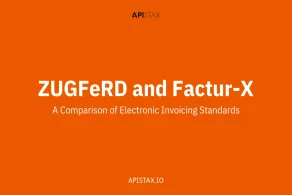ZUGFeRD and Factur-X: A Comparison of Electronic Invoicing Standards
In the digital transformation, electronic invoices play a central role. Businesses and authorities worldwide are looking for efficient, compliant, and standardized solutions to optimize invoice delivery. In Europe, two formats have particularly established themselves: ZUGFeRD and Factur-X. Both are hybrid invoicing formats that combine a PDF invoice with embedded XML data. In this post, we will examine the compatibility of these two standards, their similarities, and their differences.
What are ZUGFeRD and Factur-X?
ZUGFeRD (Central User Guide of the Forum Electronic Invoice Germany) was developed by the FeRD initiative (Forum Electronic Invoice Germany). The standard was first published in 2014 and aims to simplify the exchange of electronic invoices. In ZUGFeRD, invoice data is embedded in both a readable PDF and a structured XML file, allowing for machine processing.
Factur-X is the French counterpart to ZUGFeRD and was developed in 2017 as a joint European standard in collaboration between France and Germany. It also relies on a hybrid invoice format that combines PDF and XML.
Similarities Between ZUGFeRD and Factur-X
ZUGFeRD and Factur-X are nearly identical in their core functions, as both standards are based on the same technical foundation. The main similarities include:
1. Hybrid Format: Both standards combine a human-readable PDF file with a machine-readable XML file. This structure allows invoices to be processed both manually and automatically.
2. UN/CEFACT XML Schema: Both ZUGFeRD and Factur-X use the UN/CEFACT XML schema as a basis, ensuring compatibility between the two formats.
3. Interoperability: Thanks to their similar structure, ZUGFeRD and Factur-X are interoperable, meaning that an invoice created in ZUGFeRD can also be processed by systems designed for Factur-X, and vice versa.
4. Legal Compliance: Both formats comply with the EU Directive 2014/55/EU on electronic invoicing and corresponding national legislation.
Differences Between ZUGFeRD and Factur-X
Despite their similarities, there are some differences between the two formats:
1. Regional Adoption: ZUGFeRD is primarily used in Germany and the DACH region (Germany, Austria, Switzerland), while Factur-X is more prevalent in France. However, Factur-X is increasingly being accepted in other European countries.
2. Naming and Specifications: While ZUGFeRD is based on a German initiative and uses specifications such as "Profile EN 16931," Factur-X defines similar profiles in the French context.
3. Versions: ZUGFeRD and Factur-X have slightly different versioning, but from ZUGFeRD 2.1 and Factur-X 1.0 onwards, both standards are fully compatible. Earlier versions of ZUGFeRD (e.g., 1.0) were not yet identical to Factur-X, leading to certain incompatibilities.
Compatibility and Practical Application
The compatibility between ZUGFeRD and Factur-X from the mentioned versions means that invoices created in ZUGFeRD format can also be processed by systems designed for Factur-X. Companies engaged in international business or cross-border transactions benefit from this compatibility as they can issue and receive invoices according to the legal requirements of both countries.
Practically, this means for businesses:
- They do not need to use separate invoice formats for different countries.
- They can use a single software solution to create and receive both ZUGFeRD and Factur-X invoices.
- Compliance with the EU directive simplifies the digitization and automation of invoice processing in international supply chains.
Invoice PDF API: Support for ZUGFeRD 2.3 and Factur-X
Our Invoice PDF API provides full support for ZUGFeRD version 2.3, ensuring seamless integration of the latest invoicing standard. Since ZUGFeRD 2.3 is fully compatible with Factur-X, invoices created with our API can be processed smoothly in both the German and French contexts. This allows businesses to efficiently create and receive electronic invoices, regardless of whether they operate according to ZUGFeRD or Factur-X specifications. With the support of these formats, our API ensures maximum flexibility and future-proofing in digital invoicing.
The Future of Electronic Invoicing in Europe
The compatibility between ZUGFeRD and Factur-X highlights the trend toward standardization in Europe. Both formats provide a strong foundation for the development of a unified European solution for electronic invoicing. Through mutual recognition and the technological collaboration of the two formats, cross-border trade will continue to be simplified.
In the future, we can expect even stronger harmonization of formats and broader acceptance in other EU member states. This would not only enhance the efficiency of invoice processing but also simplify regulatory requirements for businesses.
Conclusion
ZUGFeRD and Factur-X are two complementary standards that are revolutionizing electronic invoicing in Europe. Their compatibility from the latest versions means that companies in Germany and France – and increasingly in other EU countries – can rely on a unified, interoperable standard. This promotes digitization and automation of invoicing processes while simultaneously enhancing the efficiency and legal compliance of businesses.
Looking ahead, it is expected that these standards will continue to evolve and shape the European landscape of electronic invoicing.
